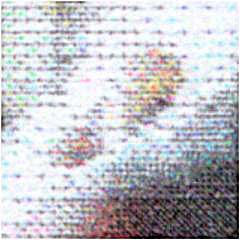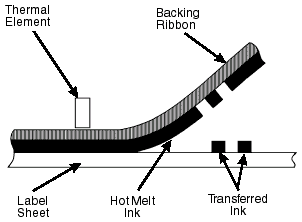
In computing, a printer is a peripheral machine which makes a persistent representation of graphics or text, usually on paper. While most output is human-readable, bar code printers are an example of an expanded use for printers. Different types of printers include 3D printers, inkjet printers, laser printers, and thermal printers.

PostScript (PS) is a page description language in the electronic publishing and desktop publishing realm. It is a dynamically typed, concatenative programming language. It was created at Adobe Systems by John Warnock, Charles Geschke, Doug Brotz, Ed Taft and Bill Paxton from 1982 to 1984.

In computer graphics and digital photography, a raster graphic represents a two-dimensional picture as a rectangular matrix or grid of square pixels, viewable via a computer display, paper, or other display medium. A raster is technically characterized by the width and height of the image in pixels and by the number of bits per pixel. Raster images are stored in image files with varying dissemination, production, generation, and acquisition formats.

Laser printing is an electrostatic digital printing process. It produces high-quality text and graphics by repeatedly passing a laser beam back and forth over a negatively-charged cylinder called a "drum" to define a differentially-charged image. The drum then selectively collects electrically-charged powdered ink (toner), and transfers the image to paper, which is then heated to permanently fuse the text, imagery, or both, to the paper. As with digital photocopiers, laser printers employ a xerographic printing process. Laser printing differs from traditional xerography as implemented in analog photocopiers in that in the latter, the image is formed by reflecting light off an existing document onto the exposed drum.

Dot matrix printing, sometimes called impact matrix printing, is a computer printing process in which ink is applied to a surface using a relatively low-resolution dot matrix for layout. Dot matrix printers typically use a print head that moves back and forth or in an up-and-down motion on the page and prints by impact, striking an ink-soaked cloth ribbon against the paper, much like the print mechanism on a typewriter or line printer. However, a dot matrix printer is able to print arbitrary patterns and not just specific characters.

A dot matrix is a 2-dimensional patterned array, used to represent characters, symbols and images. Most types of modern technology use dot matrices for display of information, including mobile phones, televisions, and printers. The system is also used in textiles with sewing, knitting and weaving.

Dye-sublimation printing is a term that convers several distinct digital computer printing techniques that involve using heat to transfer dye onto a substrate.

Dots per inch is a measure of spatial printing, video or image scanner dot density, in particular the number of individual dots that can be placed in a line within the span of 1 inch (2.54 cm). Similarly, dots per centimetre refers to the number of individual dots that can be placed within a line of 1 centimetre (0.394 in).

Konica Minolta, Inc. is a Japanese multinational technology company headquartered in Marunouchi, Chiyoda, Tokyo, with offices in 49 countries worldwide. The company manufactures business and industrial imaging products, including copiers, laser printers, multi-functional peripherals (MFPs) and digital print systems for the production printing market. Konica Minolta's Managed Print Service (MPS) is called Optimised Print Services. The company also makes optical devices, including lenses and LCD film; medical and graphic imaging products, such as X-ray image processing systems, colour proofing systems, and X-ray film; photometers, 3-D digitizers, and other sensing products; and textile printers. It once had camera and photo operations inherited from Konica and Minolta but they were sold in 2006 to Sony, with Sony's Alpha series being the successor SLR division brand.

Thermal-transfer printing is a digital printing method in which material is applied to paper by melting a coating of ribbon so that it stays glued to the material on which the print is applied. It contrasts with direct thermal printing, where no ribbon is present in the process.
Prepress is the term used in the printing and publishing industries for the processes and procedures that occur between the creation of a print layout and the final printing. The prepress process includes the preparation of artwork for press, media selection, proofing, quality control checks and the production of printing plates if required. The artwork is often provided by the customer as a print-ready PDF file created in desktop publishing.

Toner is a powder mixture used in laser printers and photocopiers to form the printed text and images on paper, in general through a toner cartridge. Mostly granulated plastic, early mixtures added only carbon powder and iron oxide, however, mixtures have since been developed containing polypropylene, fumed silica, and various minerals for triboelectrification. Toner using plant-derived plastic also exists as an alternative to petroleum plastic. Toner particles are melted by the heat of the fuser, and are thus bonded to the paper.

LaserJet as a brand name identifies the line of laser printers marketed by the American computer company Hewlett-Packard (HP). The HP LaserJet was the world’s first desktop laser printer. Canon supplies both mechanisms and cartridges for most HP laser printers; some larger A3 models use Samsung print engines.

Thermal printing is a digital printing process which produces a printed image by passing paper with a thermochromic coating, commonly known as thermal paper, over a print head consisting of tiny electrically heated elements. The coating turns black in the areas where it is heated, producing an image.

A dot matrix printer is an impact printer that prints using a fixed number of pins or wires. Typically the pins or wires are arranged in one or several vertical columns. The pins strike an ink-coated ribbon and force contact between the ribbon and the paper, so that each pin makes a small dot on the paper. The combination of these dots forms a dot matrix image. They were also known as serial dot matrix printers.
Gutenprint is a collection of free-software printer drivers for use with UNIX spooling systems, such as CUPS, lpr and LPRng. These drivers provide printing services for Unix-like systems, RISC OS and Haiku.

Oki Electric Industry Co., Ltd., commonly referred to as OKI, OKI Electric or the OKI Group, is a Japanese information and communications technology company, headquartered in Toranomon, Minato-ku, Tokyo and operating in over 120 countries around the world.
Printer Command Language, more commonly referred to as PCL, is a page description language (PDL) developed by Hewlett-Packard as a printer protocol and has become a de facto industry standard. Originally developed for early inkjet printers in 1984, PCL has been released in varying levels for thermal, matrix, and page printers. HP-GL/2 and PJL are supported by later versions of PCL.

The IBM 3800 is a discontinued continuous forms laser printer designed and manufactured by IBM. It is significant as a product because it was both the first laser printer manufactured by IBM, and the first commercially available continuous forms laser printer.

Zink is a full-color printing technology for digital devices that does not require ink cartridges and prints in a single pass.


















